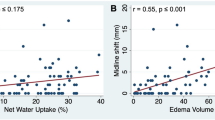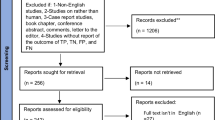Summary
We have studied the correlations between computed tomograms (CT), clinical severity at the time of onset, and subsequent development of cerebral infarction due to vasospasm in 32 cases with subarachnoid haemorrhage secondary to rupture of cerebral aneurysms. It was found that the clinical severity could be judged by CT as shown by the amount of blood in subarachnoid space. Furthermore, it was possible to predict the subsequent occurrence of cerebral infarction by sequential findings of CT. A Hounsfield number of the high density area over 60 showed good correlation with the development of cerebral infarction.
Similar content being viewed by others
References
Almauni, W. S., Richardson, A. E., Multiple intracranial aneurysms, identifying the ruptured lesion. Surg. Neurol.9 (1978), 303–305.
Endo, S., Suzuki, J., Experimental cerebral vasospasm after subarachnoid hemorrhage-development and degree of vasospasm. Stroke8 (1977), 702–707.
Hori, S., Fujiwara, S., Mori, T., Suzuki, J., Computed tomography in ruptured intracranial aneurysms. In: Cerebral aneurysms, pp. 194–207 (Suzuki, J., ed.). Tokyo: Neuron. 1979.
Kamiyama, K., Okada, J., Sonobe, M., Endo, T., Hori, S., Suzuki, J., The mechanism of cerebral vasospasm induced by oxyhemoglobin-The role of Superoxide produced by antoxidation of oxyhemoglobin. Neurol. Med. Chir., Program of the Japan Neurological Society, Tokyo, 1979.
Liliequest, B., Lindqvist, M., Valdimarsson, E., Computed tomography and subarachnoid hemorrhage. Neuroradiology14 (1977), 21–26.
Lim, S. T., Sage, D. J., Detection of subarachnoid blood clot and other thin, flat structures by computed tomography. Radiology123 (1977), 79–84.
Modesti, L. M., Binet, E. F., Value of computed tomography in the diagnosis and management of subarachnoid hemorrhage. Neurosurgery3 (1978), 151–156.
Sonobe, M., Suzuki, J., Vasospasmogenic substance produced following subarachnoid hemorrhage and its fate. Acta neurochir. (Wien)44 (1978), 97–106.
Suzuki, J., Hori, S., Prediction of reattacks following rupture of intracranial aneurysms. Neurol. Med. Chir. 15, Part I (1978), 35–39.
Author information
Authors and Affiliations
Rights and permissions
About this article
Cite this article
Suzuki, J., Komatsu, S., Sato, T. et al. Correlation between CT findings and subsequent development of cerebral infarction due to vasospasm in subarachnoid haemorrhage. Acta neurochir 55, 63–70 (1980). https://doi.org/10.1007/BF01808921
Issue Date:
DOI: https://doi.org/10.1007/BF01808921




